An unpretentious hybrid of cucumbers “Tchaikovsky f1”, which gives a rich harvest even with minimal care
A good harvest of cucumbers is the result of the painstaking work of gardeners. But there are varieties that give good performance even without the necessary care. These include the hybrid Tchaikovsky f1, which is ready to “forgive” some mistakes in care and please you with a rich and tasty harvest.
Description of cucumbers
The hybrid was bred in 2013 by breeders from the company Rijk Zwan.. They modified Kibria variety, adapting it for growing indoors, so it is suitable for lovers of greenhouses and greenhouses.
It is an early ripening variety - the first fruits appear after 40 days. Thanks to the short growing season, gardeners use Tchaikovsky f1 throughout the entire season. Like any hybrid, Tchaikovsky does not need pollination by insects. Plants planted in open ground tolerate adverse weather conditions well.
Distinctive features
Tchaikovsky - high-yielding hybrid. With proper care, you can get up to 50 kg of vegetables from 1 square meter of bed. The plant tolerates heat and cold, which makes it suitable for spring-summer and summer-autumn cultivation. An unusually persistent and hardy plant is capable of regeneration after suffering damage due to temperature changes.
In the photo - cucumber Tchaikovsky f1.
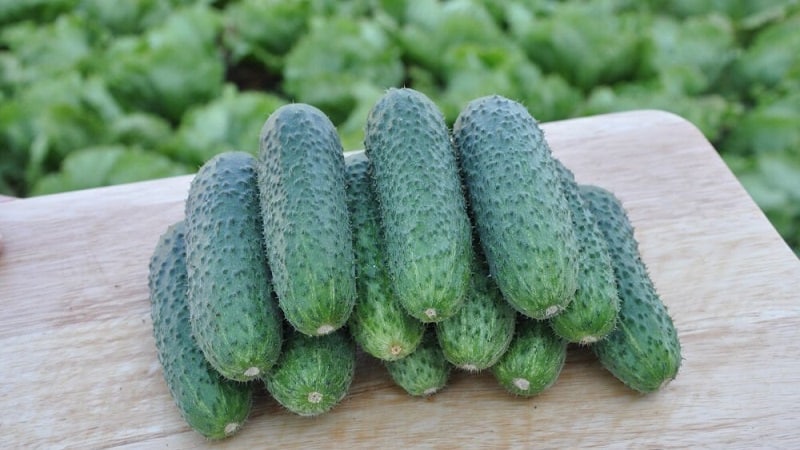
Composition, properties, benefits, calorie content
It is known that cucumber is 95% water.In the remaining 5%, nature has provided a storehouse of useful substances: vitamins A, PP, group B, potassium, magnesium, phosphorus, iron, calcium and many others.
The juice contained in cucumbers removes waste and toxins. from the body, improves the functioning of the kidneys, gastrointestinal tract, heart and blood vessels. Fiber and coarse fiber contained in the peel regulate metabolism and intestinal function. The presence of iodine in vegetables has a beneficial effect on hormonal levels. Scientists have proven the effectiveness of fruits in the fight against cancer cells, insomnia, fatigue and irritability.
Eating cucumbers promotes weight loss and rejuvenation of the body.. It has been used not only in preparations and salads, but also in face masks, lotions, and weight loss products.
100 g of product contains 0.8 g of protein, 0.1 g of fat, 2.5 g of carbohydrates and only 14 kcal, which makes the vegetable a balanced, easily digestible and affordable means of weight loss.
Characteristics
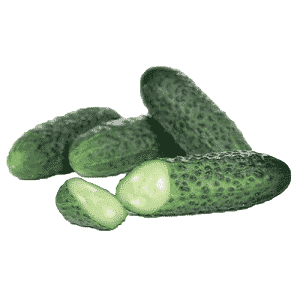 The bushes of the plant are small, so gardeners chose a hybrid for growing in greenhouses. Strong stems up to 2-2.5 meters in length cope well with the weight of ripening fruits. But it is still recommended to create support in the form of trellises and pegs. Side shoots grow in limited quantities and are able to regulate their growth themselves.
The bushes of the plant are small, so gardeners chose a hybrid for growing in greenhouses. Strong stems up to 2-2.5 meters in length cope well with the weight of ripening fruits. But it is still recommended to create support in the form of trellises and pegs. Side shoots grow in limited quantities and are able to regulate their growth themselves.
When growing in an open area, pinch the top of the bush on the 4-5th leaf and spread it into 2-3 sleeves. The small size of the rich green leaves helps retain moisture.
The fruits are cylindrical, dark green in color, the skin is covered with tubercles with spikes.. Their weight is 60-80 grams, length - 10-12 cm. The pulp is juicy, crispy, meaty, without bitterness. Ready to eat when they reach 4-5 cm in length.
The hybrid is distinguished by bunch fruiting, in one node forms up to 5 ovaries, the fruits most often ripen simultaneously. During the entire growing season, 50 kg of cucumbers are harvested from 1 square meter of plot.
How to grow your own
Growing a hybrid on your own plot is not difficult. The main thing is to provide the plant with fertilized, loose, aerated soil..
Planting by seeds and seedlings
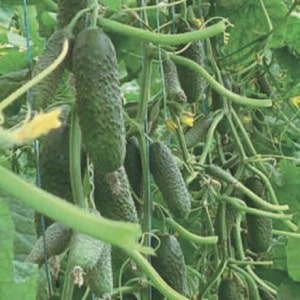 Considering that this is a Dutch hybrid, the seeds do not require pre-soaking in potassium permanganate or growth stimulants, as indicated by the labeling on the packaging. If it is present, then you don’t have to worry about seed germination.
Considering that this is a Dutch hybrid, the seeds do not require pre-soaking in potassium permanganate or growth stimulants, as indicated by the labeling on the packaging. If it is present, then you don’t have to worry about seed germination.
Vegetables are grown by seedlings and seeds. The first will give an earlier harvest, the second is suitable for those who want to collect fruits in late summer or autumn.
To obtain seedlings, seeds are placed in peat or plastic cups with substrate, 1 pc. in each, sprinkle 1-2 cm of loose soil on top, place on the windowsill and water as the top layer dries. When 4-5 true leaves appear, the plant is transferred to open ground.
Seeds or grown seedlings are planted in rows, the distance between which is 1-1.2 m, and the gap between the holes is 40 cm. No more than 5 bushes should grow on one square meter. Humus is placed at the bottom of the hole, watered and cucumbers are planted.
Important! Seedlings or seeds are planted when the soil has warmed up to 15-16 degrees and the threat of severe frost has passed.
Growing and care
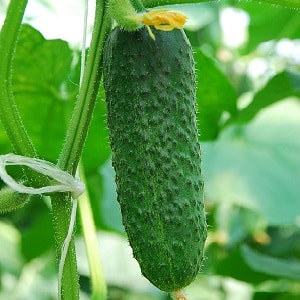 Cucumber is a moisture-loving plant, but does not tolerate waterlogging of the soil.. At the initial stages, add 10 liters of water per 1 square meter. m plot.When the stems grow and fruits begin to set, water one bush with this amount of water.
Cucumber is a moisture-loving plant, but does not tolerate waterlogging of the soil.. At the initial stages, add 10 liters of water per 1 square meter. m plot.When the stems grow and fruits begin to set, water one bush with this amount of water.
It is necessary to water at the root, avoiding water getting on the leaves., otherwise they will burn in the sun and the plant will die. In hot weather, they water more often; during heavy rains, excess water is drained by making grooves. It is best to add water in the morning or evening; its temperature should not be below 10 degrees. Watering with cold water contributes to hypothermia of the roots and their subsequent rotting.
Reference. Between waterings or after rains, the soil is loosened to provide oxygen access to the roots.
To get a large harvest, soil is necessary. feed. Complex fertilizer is applied in the spring, before digging up the area. If the bed is prepared in the fall, ammonium nitrate is added to the soil, then the area is dug up. Potassium and nitrogen are washed out over the winter, so they are added before planting seeds or seedlings.
When 2-3 true leaves appear on the shoots, a solution of potassium sulfate, nitrate and double superphosphate is added under the bush. After 2 weeks, each bush is watered with mullein infusion. During the flowering period, 2 cups of wood ash and 15 grams of urea are dissolved in 10 liters of water, then applied under the bushes. During fruiting, cucumbers are fed with a mixture of chicken manure and wood ash.
Features of cultivation and possible difficulties
For growing hybrid Tchaikovsky vertical method of placing lashes is preferable. To do this, create vertical supports to which the stems are tied. Thus, the plant is better ventilated and develops.
To get a high-quality harvest, ensure compliance with crop rotation.. It is not recommended to plant cucumbers in the same place earlier than after 4-5 years, since after cucumbers a huge number of microorganisms remain in the soil - causative agents of various diseases that can cause harm.
Reference. Cucumber does not like direct sunlight; it is better to choose a place where it is sunny in the first half of the day and shady in the second. You can plant sunflowers or corn around the bed to protect the cucumbers from the sun.
Often gardeners complain about the low germination rate of seeds planted in open ground. The cause is uninvited guests in the form of moles and ants, so before planting, the site is carefully inspected and, if pests are found, they are fought against.
Another distinctive feature The problem with growing the Tchaikovsky hybrid is that it does not tolerate thickening, so it is not recommended to plant the sprouts close to each other.
Characteristic diseases and pests, resistance
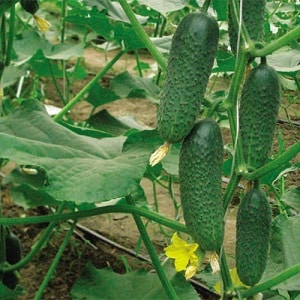 Hybrid Tchaikovsky is resistant to powdery mildew, cucumber mosaic and brown spot. But there are diseases and pests that can harm it:
Hybrid Tchaikovsky is resistant to powdery mildew, cucumber mosaic and brown spot. But there are diseases and pests that can harm it:
- In case of defeat anthracnose the leaves are treated with a 0.5% solution of copper sulfate, and then sprinkled with crushed chalk, lime or coal.
- When white rot appears the affected shoots are cut off, and the remaining shoots are treated with a solution: 2 g of vitriol and 10 g of urea per 10 liters of water.
- With melon aphids fight with the help of the drug "Inta-Vir" or a mixture of 10 liters of water, 50 g of crushed laundry soap and 200 g of ash.
- Spider mite is afraid of garlic and onions, so to combat it, dissolve 200 g of the product in 10 liters of water and spray the plant.
- If the bushes are attacked by slugs, the soil around the plants is treated with lime or ash, and the leaves are sprayed with Metaldehyde.
- From whitefly are saved by Inta-Vir.
- If the bush is affected downy mildew, the plant is sprayed with a mixture of iodine, milk and water, Bordeaux mixture or urea.
Harvesting and application
The first fruits appear 40 days after germination. When the cucumbers reach 12 cm in length, it is time to start harvesting, which lasts from June to September. If you miss the moment, the peel of the vegetable becomes hard and dense, and the pulp loses its taste, but no voids are formed inside.
Fruits can be stored in the refrigerator for about a month. They tolerate transportation well, are excellent for canning, remaining dense and crispy.
Advantages and disadvantages
The advantages include the following indicators::
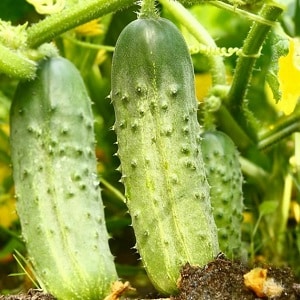 self-pollinating;
self-pollinating;- fast growing season and early fruiting;
- friendly ripening of fruits;
- resistance to temperature changes;
- high productivity;
- resistance to diseases and pests;
- excellent taste without bitterness;
- The fruits tolerate transportation well, without losing their appearance for 2-3 days after collection.
Among the shortcomings it is worth noting:
- the impossibility of growing in open ground in the regions of Siberia and the Far East;
- increased requirements for soil and fertilizing;
- the presence of thorns in young fruits;
- the need to purchase seeds every year.
Reviews
The relatively young hybrid has already received recognition from gardeners. It's hard to find negative reviews about him.
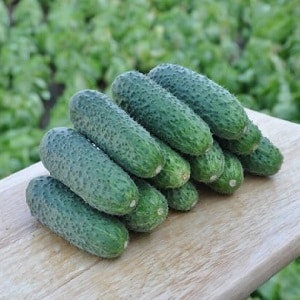 Nikolay, Ryazan: “For 3 years I have been growing this particular hybrid. Compared to other “Dutch” varieties, I note the high yield, small fruit size and lack of bitterness.
Nikolay, Ryazan: “For 3 years I have been growing this particular hybrid. Compared to other “Dutch” varieties, I note the high yield, small fruit size and lack of bitterness.
I really like it canned and fresh. The good news is that he rarely gets sick and is attacked by pests. I have a plot under the house, there are tall trees nearby, I thought that partial shade would not allow me to grow a good crop, but in the end it turned out that it was only good for him.”.
Elena, Nizhny Novgorod: “He has no equal in conservation. The cucumbers are sweet and crunchy. During growth, many side shoots are formed, each of which bears fruit. At the same time, the bush does not take up much space.".
Natalia, Perm: “I have been growing greenhouse cucumbers for 10 years. Based on personal experience, I can say: Kibria is a very early, tasty variety, suitable for eating and pickling. Tchaikovsky is like Cybria, but ripens a little later".
Conclusion
The Tchaikovsky hybrid was recently bred and is still little known to gardeners. It is suitable for cultivation in almost all regions of Russia; in colder areas it is successfully grown in greenhouses. It is not demanding in terms of care, is resistant to diseases, and its high yield and taste make it increasingly popular.